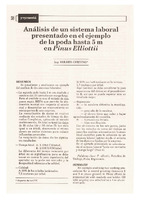| dc.creator | Gerding, Volker | |
| dc.date.accessioned | 2022-09-03T19:32:45Z | |
| dc.date.available | 2022-09-03T19:32:45Z | |
| dc.date.issued | 1993-09-01 | |
| dc.identifier.citation | Gerding, V. (1993). Análisis de un sistema laboral presentado en el ejemplo de la poda hasta 5 m en Pinus Elliottii. Yvyraretá: Revista Forestal País de Árboles. Eldorado (Misiones): UNaM. FCF; (4), pp. 38-44. | es_AR |
| dc.identifier.issn | 2469-004X | |
| dc.identifier.other | Yvy-278 | |
| dc.identifier.uri | https://hdl.handle.net/20.500.12219/3501 | |
| dc.description | Fil: Gerding, Volker. GTZ (Deutsche Gesellschaft für Technische Zusammenarbeit; Cooperación Técnica Alemana); Alemania. | es_AR |
| dc.description.abstract | Se estudiaron y analizaron un ejemplo del análisis de dos sistemas laborales:
- La segunda poda hasta 5 m con machete y escalera (A); (B) serrucho con mango largo. Para el análisis se usa el método de seis pasos según REFA que permite la abstracción mental con respecto al estado real y desarrollar un mejoramiento en varias partes de una empresa.
La recopilación de datos se realizó mediante dos estudios de tiempo de Jornadas Completas, aplicando el método multimomento. En total se tomaron los datos de 38 ciclos (A) y 36 ciclos (B) (un ciclo igual a un árbol), observando al mismo obrero en ambos sistemas para reducir influencias personales.
La recopilación de datos dio los siguientes resultados:
- Tiempo total:
A: 1.129,6 CM/árbol.
B: 1.059,72 CM/árbol.
La diferencia del tiempo necesario por árbol no es significativa, pero se debe tomar en cuenta la poca experiencia del operador en la poda con serrucho y la desigualdad referente a la calidad.
-Calidad:
A: 85% de los árboles lastimados. 7,3 muñones por árbol.
B: 20 % con lastimaduras en la corteza. 1,7 muñones por árbol.
Aquí también se debe considerar la poca experiencia del obrero en el procedimiento B, así que se puede esperar aún un resultado mejor.
-Ergonomía:
A: -La escalera dificulta la movilización.
-peso alto de la escalera.
-el obrero tiene que subir y bajar aproximadamente 80 veces/día.
B: -herramienta liviana.
- libre movilización.
Con el sistema de los seis pasos, junto con los métodos de toma del tiempo se posee las medidas adecuadas con la exactitud científica para la selección de un sistema laboral óptimo desde el criterio de los objetivos fijados por la empresa.
En el ejemplo presentado se seleccionaría el sistema laboral "poda con serrucho y mango largo" (Paso 6). | es_AR |
| dc.description.abstract | An example analysing two working procedures for a second pruning (between 2 and 5 m above ground) in Pinus elliottii is presented (A) with machete and ladder. (B) with a pruning saw attached to a 4 m aluminium pole.
The six-steps-system according to REFA is used for the analysis, which allows a mental abstraction with respect to the real situation and the development of modifications for different areas within a company.
Gathering of the basic data for the study was accomplished by a day - long time measurement for each of the two procedures, using the multi-moment-method. A total 38 cycles were taken for procedure (A), and 36 cycles for procedure (B), one cycle corresponding to one tree. In order to eliminate differences between personnel, both procedures were executed by the same worker.
Data processing resulted in the following total times for each tree: Procedure (A) 1129.6 CM/tree = 11296 min/tree.
Procedure (B) 1059.7 CM/tree = 10 597min/tree.
The resulting difference of 69.9 CM/tree between the two procedures is not significant, and the inexperience of the worker with procedure (B) and the differences in quality should also be taken into account.
With procedure (A), 85% of the trees resulted damaged, and on the average each tree had 7.3 stubs, whereas with procedere (B) only 20% of the trees were damaged, with only l.7 stubs per tree. Also with respect to the quality of the pruning, the little experience of the worker in using the pruning saw with the 4 m aluminium pole should be taken into account, which gives hope to even better results.
Discussing the results from an ergonomic point of view:
Procedure (A)
-the ladder hinders free movement in the stand.
-the high weight of the ladder.
-the worker has to climb up and down.
-the ladder approximately 80 times per day.
Procedure (B)
-lightweight equipment.
-unhindered movement within the stand.
Using the six-steps-system complemented by an effective time-taking method, one disposes of an adequate set of tools for selecting an optimized working system which will satisfy the objectives set by an enterprise.
In the present example, the working system (B) "pruning with a saw attached to a large pole" would be chosen (step 6). | es_AR |
| dc.format | application/pdf | |
| dc.format.extent | 2.540 MB | |
| dc.language.iso | spa | es_AR |
| dc.publisher | Universidad Nacional de Misiones. Facultad de Ciencias Forestales. Instituto subtropical de Investigaciones Forestales | es_AR |
| dc.relation | info:eu-repo/semantics/altIdentifier/urn/http://www.yvyrareta.com.ar/index.php/item/344-sept-1993-n-4 | |
| dc.rights | Atribución-CompartirIgual 4.0 Internacional | |
| dc.rights | info:eu-repo/semantics/openAccess | |
| dc.rights.uri | http://creativecommons.org/licenses/by-sa/4.0/ | |
| dc.subject | Pinus elliottii | es_AR |
| dc.subject | Estudios de trabajo | es_AR |
| dc.subject | Poda | es_AR |
| dc.subject | Ergonomía | es_AR |
| dc.subject | Work studies | en |
| dc.subject | Pruning | en |
| dc.subject | Ergonomy | en |
| dc.title | Análisis de un sistema laboral presentado en el ejemplo de la poda hasta 5 m en Pinus Elliottii | es_AR |
| dc.type | info:eu-repo/semantics/article | |
| dc.type | info:ar-repo/semantics/artículo | |
| dc.type | info:eu-repo/semantics/publishedVersion | |




